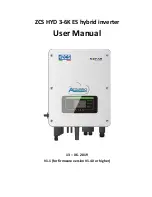
11
Heat Controller
VMH 09/12/18/24 SD Inverter Mini-Split
Leak Test, Evacuation & Release of Refrigerant
The condensing unit is supplied with a R-410a
factory approximately 25 ft. (7.6m) of line charge,
sufficient for most matching evaporator units.
Charge must be added for interconnecting tubing.
See Field Charging Section of this manual.
The unit’s service valves are shipped in the closed
position and should not be opened until final
connections and evacuation are completed.
WARNING
It is illegal to discharge refrigerant into the
atmosphere. Use proper reclaiming methods
and equipment when working on the refrigerant
containing parts of the unit. Service should be
performed by a QUALIFIED service agency and
certified technicians.
Electrical Precautions
1. Refer to the unit’s rating plate for power supply voltage. Ensure adequate electrical supply
is available.
2. Ensure the air conditioner is properly grounded.
3. Connect wiring to the unit according to the electrical diagram located on the unit.
4. All wiring must comply with local and national electrical codes and be installed by a quali
-
fied electrician.
5. An individual branch circuit must be available.
6. Properly size the HACR breaker/fuse based on nameplate date.
7. Improper connections and inadequate grounding can cause injury or death.
8. Connect all wiring tightly. Loose wiring may cause overheating at connection points and
create a possible fire hazard.
9. Match terminal strip numbers/labels and colors between indoor and outdoor wiring. Errone
-
ous wiring may cause fire/shock.
10. Always use strain reliefs and outdoor cable cover to protect wiring.
CAUTION
The recommended procedure for leak test, evacuation,
and release of refrigerant is outlined below:
1. Complete the final piping connections to the indoor
and outdoor units using high temperature brazing
alloy.
2. Connect a charging manifold to the service ports
provided at the service valves.
3. Pressurize the lines and evaporator with nitrogen
and leak check all connections with soap bubbles.
Repair as necessary any faulty joints. If brazing is
required be sure to RELEASE THE NITROGEN
FIRST. Re-test as needed.
4. Connect a vacuum pump to the manifold center
connection, start the pump and open the manifold
valves.
5. Evacuate to 500 microns or less for a minimum of
30 minutes. Close the manifold valves and shut off
the pump. Note the vacuum reading and wait 15
minutes. Take a new vacuum reading. A reading
of 800 microns or higher indicates the presence of
moisture or a leak.
6. Repair as necessary and repeat steps 3, 4 & 5.
7. Confirm that manifold valves are closed and
disconnect the vacuum pump.
8. Remove the caps from the services valves. Open
the valves to the fully ‘back-seat’ position. Replace
service valve caps and tighten.


































